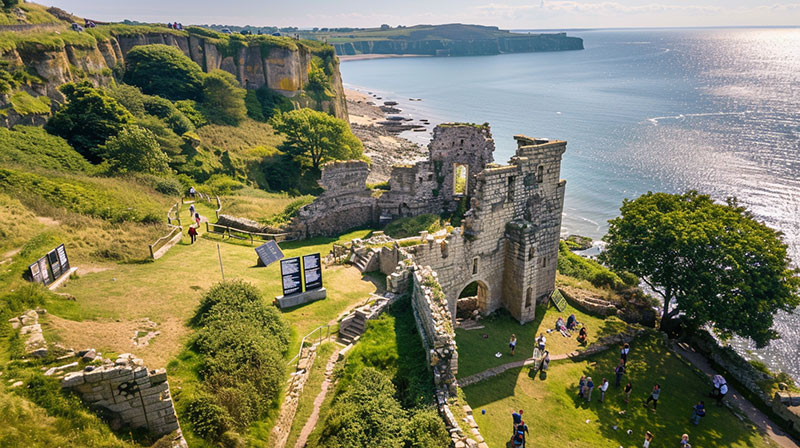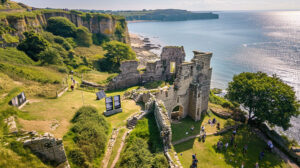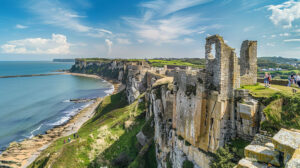Scarborough Castle stands majestically atop a rugged cliff overlooking the North Sea, offering stunning views and a journey through centuries of English history. This ancient fortress has witnessed dramatic events, from Roman times to the present day, making it one of Scarborough’s most iconic landmarks. Here’s an in-depth look at the history of Scarborough Castle.
Roman Beginnings
The history of Scarborough Castle dates back to the Roman era. Around 370 AD, the Romans constructed a signal station on the site to warn of approaching enemy ships. This early fortification was part of a chain of coastal defenses stretching along the eastern coast of Britain. Remnants of the Roman signal station can still be seen today, providing a glimpse into the distant past.
Key Features:
Roman Signal Station: The remains include foundations and fragments of walls, giving visitors an idea of the structure’s original size and purpose.
Strategic Location: Positioned high on a cliff, the site offered an excellent vantage point for monitoring sea traffic and potential threats.
Anglo-Saxon and Viking Era
After the Romans left Britain, the site of Scarborough Castle saw intermittent use by Anglo-Saxon settlers. The strategic location remained important, and it is believed that a wooden fortification existed here during the Anglo-Saxon period. In the 10th century, Viking raids on the Yorkshire coast led to the destruction and rebuilding of several settlements, including Scarborough.
Key Features:
Anglo-Saxon Fortifications: While little remains from this period, the site’s continued use highlights its strategic importance.
Viking Influence: Scarborough’s name is derived from the Viking word ‘Skaroaborg,’ indicating the presence of a fortified settlement during the Viking era.
Medieval Expansion
The medieval period saw significant developments at Scarborough Castle. In the 12th century, King Henry II recognized the strategic importance of the site and commissioned the construction of a stone castle. The building of the castle began in 1157 and continued under subsequent monarchs, including King John and Henry III.
Key Features:
The Keep: The massive stone keep, built by Henry II, is one of the castle’s most striking features. It served as both a residence and a stronghold.
Curtain Walls: Thick stone walls surrounded the keep, providing robust defense against invaders.
Gatehouse: The gatehouse controlled access to the castle, with a drawbridge and portcullis adding to its defensive capabilities.
Chapel: A chapel was built within the castle grounds, providing a place of worship for the garrison and residents.
Role in Conflicts
Throughout its history, Scarborough Castle played a crucial role in several conflicts. Its strategic location made it a valuable military asset during times of war and rebellion.
The Barons’ War:
In the early 13th century, Scarborough Castle was involved in the Barons’ War, a conflict between rebellious barons and King John. The castle was besieged and captured by the barons in 1216.
The Wars of the Roses:
During the Wars of the Roses, Scarborough Castle changed hands several times. Both the Lancastrians and Yorkists recognized its strategic importance. In 1461, the castle was seized by the Yorkist forces.
The Pilgrimage of Grace:
In 1536, Scarborough Castle was involved in the Pilgrimage of Grace, a popular uprising against Henry VIII’s religious reforms. The castle’s garrison held out against the rebels, maintaining the king’s control over the region.
The English Civil War:
Scarborough Castle’s most dramatic chapter came during the English Civil War (1642-1651). Initially held by Royalist forces, the castle endured two major sieges by Parliamentarian troops. The most notable siege occurred in 1645, led by Sir John Meldrum. Despite fierce resistance, the Royalists eventually surrendered due to starvation and lack of supplies.
Siege Damage: The intense bombardment during the siege caused significant damage to the castle, including the destruction of part of the keep. The scars of this conflict are still visible today, adding to the castle’s historic allure.
Post-Medieval Decline and Restoration
Following the English Civil War, Scarborough Castle fell into disrepair. Its military significance diminished, and the castle was largely neglected. However, interest in the site revived during the 18th and 19th centuries, as antiquarians and tourists began to appreciate its historical value.
Victorian Restoration:
In the 19th century, efforts were made to preserve and restore parts of the castle. The Victorians undertook several restoration projects, stabilizing the ruins and making the site more accessible to visitors.
Tourism Boom:
The Victorian era saw a boom in tourism, with visitors flocking to Scarborough for its seaside attractions and historic sites. Scarborough Castle became a popular destination, contributing to the town’s reputation as a premier holiday spot.
20th Century to Present
In the 20th century, Scarborough Castle became a popular tourist destination. It was placed under the care of English Heritage, ensuring its preservation for future generations. Today, the castle is a well-maintained historic site, attracting visitors from around the world.
Modern Features:
Visitor Centre: The castle’s visitor centre offers informative exhibits and displays, detailing the site’s history and significance.
Interactive Exhibits: Engaging, interactive displays provide insights into medieval life, the castle’s construction, and its role in historical conflicts.
Family-Friendly Activities: The castle grounds feature family-friendly activities, including themed trails and educational programmes.
Exploring Scarborough Castle Today
A visit to Scarborough Castle offers a unique opportunity to explore centuries of history. The site is well-preserved, with informative signage and guided tours available to enhance the visitor experience.
Key Areas to Explore:
The Keep: Climb to the top of the keep for breathtaking views of Scarborough and the North Sea. The keep’s interior includes exhibits on medieval life and the castle’s construction.
Curtain Walls: Walk along the curtain walls to get a sense of the castle’s formidable defenses. Interpretive panels provide information about the castle’s military architecture.
The Roman Signal Station: Visit the remains of the Roman signal station and learn about its role in ancient coastal defense.
The Inner Bailey: Explore the inner bailey, where you can see the foundations of buildings that once housed the castle’s residents and garrison.
Events and Activities
Scarborough Castle hosts a variety of events and activities throughout the year, making it an engaging destination for visitors of all ages.
Medieval Reenactments:
Experience history come to life with medieval reenactments, featuring knights in armour, archery displays, and interactive demonstrations.
Historical Talks and Tours:
Join guided tours and attend talks by historians to gain deeper insights into the castle’s past and its role in key historical events.
Family Events:
Special family-friendly events are held during school holidays, including treasure hunts, storytelling sessions, and craft workshops.
Seasonal Celebrations:
The castle celebrates seasonal events, such as Halloween and Christmas, with themed activities and entertainment.
Educational Importance
Scarborough Castle is not just a tourist attraction; it’s an educational resource that provides valuable insights into English history. Schools and educational groups frequently visit the castle to learn about medieval architecture, historical conflicts, and the daily life of people who lived there.
Educational Programmes:
The castle offers tailored educational programmes for students, including guided tours, hands-on activities, and interactive learning experiences.
Historical Research:
Scarborough Castle is also a site of ongoing historical research. Archaeologists and historians continue to study the castle, uncovering new information about its construction, use, and significance over the centuries.
Preservation Efforts
Maintaining a historic site like Scarborough Castle requires ongoing preservation efforts. English Heritage is committed to conserving the castle’s structures and artifacts for future generations.
Conservation Projects:
Regular conservation projects are undertaken to stabilize the ruins, prevent further decay, and restore damaged sections of the castle.
Community Involvement:
The local community plays a vital role in the preservation of Scarborough Castle. Volunteers, local historians, and supporters contribute to the castle’s upkeep and educational programmes.
Conclusion
Scarborough Castle is more than just a historic site; it’s a journey through time, offering a window into England’s rich and turbulent past. From its Roman origins to its medieval grandeur and its role in significant conflicts, the castle has a story to tell at every turn. Whether you’re a history enthusiast, a family looking for a fun day out, or simply someone who appreciates stunning coastal views, Scarborough Castle has something to offer.
So, why not plan your visit to Scarborough Castle and immerse yourself in the history and beauty of this remarkable site? With its well-preserved ruins, informative exhibits, and engaging events, Scarborough Castle promises an unforgettable experience for all who visit. Book your stay in one of Scarborough’s charming holiday lets and make the most of your time exploring this historic gem on the Yorkshire coast.













